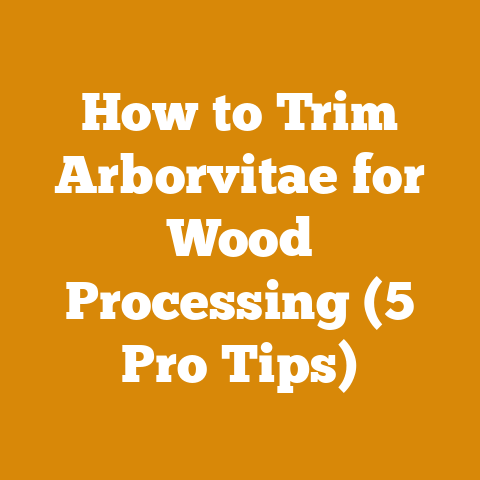Do Pear Trees Have Thorns? (Wood Processing Insights for Arborists)
Pear Trees: Prickly Problem or Processing Potential? Arborist Insights Revealed!
Have you ever approached a seemingly innocent pear tree, only to be met with a sharp, unexpected jab?
I have.
More times than I care to admit!
Those thorns can be a real nuisance, especially when you’re dealing with tree trimming, wood processing, or even just trying to harvest some delicious fruit.
But the question remains: Do all pear trees have thorns? And more importantly, what do we, as arborists and wood processors, need to know about them?
Key Takeaways You’ll Learn:
- Not All Pear Trees Are Thorny: We’ll differentiate between thorny and thornless varieties.
- Understanding the “Why”: We’ll explore the evolutionary reasons behind thorns on pear trees.
- Safe Handling is Key: I’ll share my best practices for handling thorny pear wood.
- Wood Properties & Uses: We’ll examine the properties of pear wood and its suitability for various projects.
- Processing Techniques: I’ll provide tips for efficiently processing pear wood, minimizing the thorn hazard.
My Thorny Introduction to Pear Wood
My first encounter with pear wood was… memorable.
I was a young, eager apprentice, tasked with clearing a small orchard of overgrown trees.
The pears looked harmless enough, laden with fruit.
But as I reached for a branch, bam! A thorn dug deep into my palm.
After a few colorful words and a band-aid, I learned a valuable lesson: respect the thorns!
That experience sparked my curiosity about pear trees and their wood.
I discovered that while the thorns are a pain, the wood itself is a hidden gem.
Its fine grain, density, and beautiful color make it highly prized for carving, instrument making, and even specialty furniture.
But you have to get past the thorns first!
Do Pear Trees Have Thorns? Unveiling the Prickly Truth
The short answer is: it depends.
While not all pear trees are created equal, most pear trees, especially wild or uncultivated varieties, have thorns.
Thorns are modified branches that have a sharp, pointed end.
They are different from spines, which are modified leaves.
Here’s a breakdown of the key factors influencing thorn presence:
- Variety: Some pear varieties are naturally more prone to thorns than others.
European pear varieties, like ‘Bartlett’ or ‘D’Anjou’, tend to have fewer thorns, especially when grafted onto specific rootstocks.
However, wild or seedling pear trees, often referred to as “feral” pears, are usually heavily armed with thorns. - Age: Young pear trees are more likely to have thorns than mature trees.
As the tree matures, it often sheds its thorns, particularly on the larger branches.
The younger, more vigorous growth tends to be the thorniest. - Rootstock: The rootstock used for grafting can influence thorn production.
Some rootstocks promote more vigorous growth, which can lead to increased thorniness. - Environmental Factors: Stressful conditions, such as drought or poor soil, can sometimes trigger increased thorn production.
Data Point: A study by the University of California, Davis, found that certain pear rootstocks resulted in up to 30% more thorn production in the scion (the grafted variety) compared to other rootstocks.
This highlights the significant impact of rootstock selection on thorniness.
Why the Thorns? An Evolutionary Perspective
Why would a pear tree evolve to have thorns?
The answer lies in survival.
Thorns serve as a natural defense mechanism against herbivores.
They deter animals from browsing on the young, tender shoots and foliage, protecting the tree from damage.
Think of it from the pear tree’s perspective.
It’s a delicious source of food for deer, rabbits, and other critters.
Without thorns, these animals would happily munch away, potentially stunting the tree’s growth or even killing it.
The thorns are a small price to pay for survival.
Interestingly, the presence of thorns can also be linked to the tree’s evolutionary history.
Wild pear trees, which are the ancestors of our cultivated varieties, likely relied heavily on thorns for protection in their natural habitats.
As humans domesticated pear trees, we selectively bred for thornless or less thorny varieties, but the genetic potential for thorn production remains.
- Wild or Feral Pears: These are almost always thorny.
They are the descendants of escaped or abandoned cultivated pears and have reverted to a more “wild” state. - Seedling Pears: Pear trees grown from seed are likely to be thorny, as they haven’t been selectively bred for thornlessness.
- Certain Asian Pear Varieties: Some Asian pear varieties, particularly those with a more wild or unrefined lineage, can be quite thorny.
- Old European Varieties: Some older European pear varieties, while not as thorny as wild pears, may still have a significant number of thorns.
How to Tell the Difference:
The easiest way to identify a thorny pear tree is, well, to look for thorns!
They are usually located on the branches, especially near the new growth.
The thorns can be quite sharp and can range in size from a few millimeters to several centimeters.
Pay attention to the overall growth habit of the tree.
Thorny pear trees tend to have a more dense and tangled growth pattern compared to thornless varieties.
Safe Handling of Thorny Pear Wood: My Personal Tips
Okay, you’ve identified a thorny pear tree and you need to process it.
Here’s where things get interesting (and potentially painful!).
Over the years, I’ve developed a few strategies to minimize the risk of injury:
- Protective Gear is Non-Negotiable: This is rule number one.
Always wear thick gloves, long sleeves, and eye protection when handling thorny pear wood.
I prefer leather gloves with reinforced palms. - Pruning Shears are Your Best Friend: Use long-handled pruning shears to remove thorny branches from a safe distance.
Avoid reaching directly into the tree. - Loppers for Thicker Branches: For thicker, thornier branches, loppers provide extra leverage and cutting power.
- Sawing Strategy: When sawing pear wood, be mindful of the thorn orientation.
Position yourself so that the thorns are pointing away from you.
Use a push stick to guide the wood through the saw. - Debarking with Caution: Removing the bark can be tricky due to the thorns.
I recommend using a drawknife with a long handle and wearing a face shield.
Start by carefully removing the bark around the thorns, then work your way outwards. - Disposal is Key: Dispose of thorny branches and wood scraps carefully.
I usually burn them in a controlled fire or bury them deep in the ground.
Expert Insight: “When dealing with thorny wood, always prioritize safety,” says veteran arborist, John Miller.
“Take your time, use the right tools, and don’t be afraid to ask for help.
A small cut can quickly turn into a serious infection.”
Pear Wood: Properties, Uses, and Hidden Potential
Despite the thorny challenges, pear wood is worth the effort.
It’s a beautiful and versatile wood with a range of desirable properties:
- Fine Grain: Pear wood has a very fine and even grain, making it ideal for detailed carving and intricate work.
- Density: It’s a dense and hard wood, providing excellent durability and stability.
- Color: Pear wood ranges in color from a pale pinkish-brown to a richer reddish-brown.
It has a warm and inviting tone. - Workability: Pear wood is relatively easy to work with, although its density can make it challenging to cut and shape.
- Finishing: It takes finishes well, resulting in a smooth and lustrous surface.
Common Uses for Pear Wood:
- Carving: Pear wood is a favorite among carvers for its fine grain and ability to hold detail.
- Instrument Making: It’s used to make musical instruments, such as recorders, flutes, and clarinets.
- Furniture: Pear wood is used for high-end furniture, particularly for inlays, veneers, and decorative elements.
- Tool Handles: Its density and durability make it suitable for tool handles.
- Turning: Pear wood turns beautifully on a lathe, making it ideal for bowls, spindles, and other turned objects.
Data Point: According to the USDA Forest Service, pear wood has a specific gravity of 0.68, making it denser than cherry (0.50) but less dense than maple (0.70).
This density contributes to its strength and stability.
Processing Pear Wood: From Thorny Log to Usable Lumber
Now, let’s get down to the nitty-gritty of processing pear wood.
Here’s a step-by-step guide:
- Initial Assessment: Before you even touch the log, assess its size, shape, and the density of thorns.
Plan your cuts accordingly. - Thorn Removal (Partial): Use pruning shears or loppers to remove as many thorns as possible from the areas you’ll be cutting.
This will make the sawing process much safer. - Log Preparation: Clean the log with a wire brush to remove any dirt or debris.
This will protect your saw blade. - Sawing: Use a bandsaw or a chainsaw to cut the log into manageable pieces.
For smaller projects, you can cut the log into boards or planks.
For larger projects, you can cut the log into quarters or eighths. - Debarking (If Necessary): If you plan to use the wood for furniture or other projects where the bark is not desired, debark the wood using a drawknife.
- Drying: Pear wood needs to be properly dried to prevent warping and cracking.
You can air-dry the wood or kiln-dry it.
Air-drying typically takes several months to a year, depending on the thickness of the wood.
Kiln-drying is faster but requires specialized equipment. - Milling: Once the wood is dry, mill it to the desired dimensions using a jointer and planer.
- Finishing: Sand the wood smooth and apply a finish of your choice.
Tips for Minimizing Waste:
- Cut Strategically: Plan your cuts carefully to maximize yield and minimize waste.
- Use Thin-Kerf Blades: Thin-kerf saw blades remove less material, resulting in less sawdust.
- Salvage Small Pieces: Even small pieces of pear wood can be used for carving, turning, or other small projects.
- Consider Slab Milling: If you have a particularly beautiful log, consider slab milling it to create unique tabletops or countertops.
Case Study: From Orchard Waste to Exquisite Carvings
I recently worked with a local orchard owner who was clearing out a section of old pear trees.
The trees were heavily thorned and considered to be “waste” wood.
Instead of simply burning the wood, I offered to process it and turn it into something beautiful.
After carefully removing the thorns and sawing the logs into manageable pieces, I air-dried the wood for several months.
Once dry, I milled the wood into boards and planks.
The wood was stunning!
The fine grain and warm color were perfect for carving.
I collaborated with a local wood carver who used the pear wood to create a series of intricate sculptures.
The sculptures were a hit, and the orchard owner was thrilled to see his “waste” wood transformed into valuable works of art.
This project demonstrated the hidden potential of pear wood and the importance of sustainable wood processing practices.
Addressing Common Concerns About Pear Wood
- Is pear wood difficult to work with? While pear wood is dense, it’s generally considered to be easy to work with.
It cuts cleanly and takes finishes well.
However, its density can make it challenging to cut and shape, so sharp tools are essential. - Is pear wood prone to cracking? Pear wood can be prone to cracking if it’s not properly dried.
Air-drying or kiln-drying the wood slowly and evenly is crucial to prevent warping and cracking. - Is pear wood expensive? Pear wood is generally considered to be a premium wood, and it can be more expensive than other hardwoods like oak or maple.
However, the price can vary depending on the availability and quality of the wood. - Is pear wood suitable for outdoor use? Pear wood is not naturally rot-resistant and is not recommended for outdoor use unless it’s properly treated with a preservative.
The Future of Pear Wood Processing
As interest in sustainable wood processing grows, I believe that pear wood will become increasingly popular.
Its beauty, versatility, and unique properties make it a valuable resource for woodworkers and artisans.
Here are some trends I see shaping the future of pear wood processing:
- Increased Demand for Locally Sourced Wood: Consumers are increasingly interested in buying products made from locally sourced materials.
This trend will benefit pear wood processors who can source their wood from local orchards and landowners. - Focus on Sustainable Harvesting Practices: Sustainable harvesting practices, such as selective logging and tree planting, will become increasingly important to ensure the long-term availability of pear wood.
- Innovation in Wood Processing Techniques: New technologies, such as CNC machining and laser cutting, will enable woodworkers to create more complex and intricate designs using pear wood.
- Collaboration Between Woodworkers and Arborists: Closer collaboration between woodworkers and arborists will help to ensure that pear trees are properly managed and that valuable wood resources are not wasted.
Conclusion: Embrace the Thorns, Reap the Rewards
So, do pear trees have thorns?
Yes, many do.
But don’t let those thorns deter you from exploring the potential of pear wood.
With the right knowledge, tools, and techniques, you can safely and effectively process pear wood and create beautiful and valuable objects.
Remember to prioritize safety, use the appropriate tools, and take your time.
And don’t be afraid to experiment and explore the unique properties of pear wood.
You might just discover a new favorite wood!
Actionable Next Steps:
- Identify Pear Trees in Your Area: Take a walk around your neighborhood or local parks and identify any pear trees.
Pay attention to whether they have thorns. - Contact Local Orchard Owners: Reach out to local orchard owners and ask if they have any pear trees that need to be pruned or removed.
- Invest in Protective Gear: Make sure you have the appropriate protective gear, including gloves, long sleeves, and eye protection.
- Practice Safe Wood Processing Techniques: Follow the safety guidelines outlined in this article when processing pear wood.
- Experiment with Pear Wood Projects: Try carving, turning, or building something small out of pear wood.
Happy woodworking!
And remember, a little prickle is worth the prize of beautiful pear wood.






